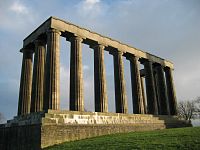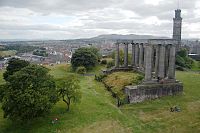- National Monument of Scotland
-
- Not to be confused with the National Wallace Monument in Stirling.
 The National Monument, on Calton Hill, Edinburgh, viewed from the front
The National Monument, on Calton Hill, Edinburgh, viewed from the front
 The National Monument, viewed from the north, with Nelson's Monument in the background.
The National Monument, viewed from the north, with Nelson's Monument in the background.
The National Monument of Scotland, popularly referred to as Scotland's Disgrace, the Pride and Poverty of Scotland or Edinburgh's Shame, is an unfinished building on Calton Hill in Edinburgh. It is Scotland's national memorial to the Scottish soldiers and sailors who died fighting in the Napoleonic Wars,[1][2] and was intended, according to the inscription, to be "A Memorial of the Past and Incentive to the Future Heroism of the Men of Scotland".[3]
The monument dominates the top of Calton Hill, just to the east of Edinburgh's New Town. It was designed during 1823-6 by Charles Robert Cockerell and William Henry Playfair and is modelled upon the Parthenon in Athens. Construction started in 1826 and the building was left in its unfinished state in 1829.
Contents
Construction
As early as 1816, the Highland Society of Scotland called for the construction of a national monument to commemorate the fallen in the Napoleonic Wars.[1] Initially the Mound was considered as a site, but was rejected in favour of Calton Hill.[4]
In January 1822, a proposal was put forward to 'erect a facsimile of the Parthenon' at a cost of some £42,000. The appeal found support amongst many prominent Edinburgh residents such as Sir Walter Scott, Henry, Lord Cockburn and Francis, Lord Jeffrey.[5] In July 1822 the Royal Association of Contributors to the National Monument of Scotland was incorporated by an Act of Parliament. The foundation stone was laid, amid great pomp and ceremony, the following month.
Sixteen months after the initial appeal, only £16,000 had been found with the possibility of a £10,000 grant from Parliament. In 1826, the building was finally commissioned and work began.[5] The builder contracted to execute the work was Messrs William Wallace & Son.[3]
Originally, the building was planned to have extensive catacombs in the area supporting the main structure, to provide a burial place for significant figures,[5][6] intended as a "Scottish Valhalla".[2] A minute of the Royal Association in 1826 stated that the building was:[3]
-
"to adopt the Temple of Minerva or Parthenon of Athens, as the model of the Monument, and to restore to the civilised world that celebrated and justly admired edifice, without any deviation whatever, excepting the adaptation of the sculpture to the events and achievements of the Scottish Heroes, whose prowess and glory it is destined to commemorate and perpetuate, and part of which monument or building must, in terms of the said Act, be appropriated as a church or place of Divine worship, to be maintained in all time coming by the said Association"
Laying of the foundation stone
The foundation stone, which weighs 6 tons and is 228 feet long by 102 feet broad, was laid on 27 August 1822, during the visit of George IV to Scotland.
The Duke of Hamilton (the most senior non-royal Scottish noble and the Grand Master of Scotland) lead a procession of masonic lodges, royal commissioners and other dignitaries from Parliament Square to the top of Calton Hill. The procession was escorted by the Scots Greys and the 3rd Dragoons.
The deposition of the inscription plates in the stone was accompanied by cannon salutes from Edinburgh Castle, Salisbury Crags, Leith Fort and the royal squadron lining the roads.[2]
Proposals for completion
Particularly due to the use of high-quality materials, the project ended in 1829 with funds running out.[5] Local legend suggests that the city of Glasgow apparently offered to cover the costs but Edinburgh was too proud to accept the other city's charity. As a result, the monument was for long referred to by the nickname Edinburgh's Disgrace or Edinburgh's Folly.[7]
Early proposals for completion work tended to focus on following the original plans, however, during the early 20th century several alternative plans were proposed:[1]
- as a monument to Queen Victoria (1901)
- as a monument commemorating the 1707 Act of Union with England (1907)
- as a new Scottish National Gallery (1907)
- as a Scottish Parliament building (1908)
- as a memorial to those that fell in the Great War (1918, George Washington Browne)
Subsequent attempts to 'complete' the National Monument have never borne fruit for reasons of either cost or lack of local enthusiasm. A proposal in 2004 met with a mixed reception.[8]
360° view of the Calton Hill as seen from the National Monument, Edinburgh. Nelson's Monument is also visible in between columns in the center. To the right side are views of Firth of Forth. To the left rise Arthur's Seat and Holyrood Park.
References
- ^ a b c "National Monument - Data extracted from Scottish Ministers' Statutory List". Edinburgh: Historic Scotland. http://hsewsf.sedsh.gov.uk/hslive/hsstart?P_HBNUM=27820. Retrieved 28 October 2011.
- ^ a b c Grant, James (1887). "15". Old and new Edinburgh: its history, its people, and its places. 3. Cassell. http://www.oldandnewedinburgh.co.uk/volume3/page121.html. Retrieved 7 November 2011.
- ^ a b c "Contract between Michael Linning, Honorary Secretary to the Royal Association of Contributors to the National Monument of Scotland, incorporated by Act of Parliament, as specially and duly authorised by minute of a meeting of the Committee of Management or Directors held at Edinburgh, on the second day of September 1826, the Right Hon. William Trotter, Lord Provost of Edinburgh, in the chair, &c., on the one part, and William Wallace and Lewis Alexander Wallace, builders in Edinburgh, as principals, and George Chalmers, plumber in Edinburgh, and Richard Clark, chair manufacturer in Leith Walk, as sureties and cautioners, on the other part". Proceedings of the Society of Antiquaries of Scotland (Edinburgh: Neill and Company) XXII. 23 January 1888. http://www.archive.org/stream/proceedingssoci18unkngoog/proceedingssoci18unkngoog_djvu.txt. Retrieved 7 November 2011.
- ^ Withers, C. (2001). Lynch, Michael. ed. The Oxford companion to Scottish history. Oxford Companions Series. Oxford University Press. pp. 428. ISBN 9780192116963.
- ^ a b c d Youngson, A.J., The Making of Classical Edinburgh, Edinburgh University Press (Edinburgh, 1966; Reprinted 1975), pp. 159-161
- ^ Stark, John (June 1823). 3. ed. Picture of Edinburgh: containing a description of the city and its environs. J. Anderson. pp. 78-79. http://books.google.co.uk/books?id=ARcvAAAAMAAJ&pg=PA78&dq=%22National+Monument+of+%22&hl=en&ei=zIO3Trf4AYKHrAePh53IAw&sa=X&oi=book_result&ct=result&resnum=1&sqi=2&ved=0CCwQ6AEwAA#v=onepage&q=%22National%20Monument%20of%20%22&f=false.
- ^ "Edinburgh trams: Councillors vote on trams". BBC News. 2011-06-30. http://www.bbc.co.uk/news/uk-scotland-13971733.
- ^ Architect flags up plan to finish 'Edinburgh's Disgrace' - Edinburgh Evening News
Further reading
- Linning, Michael (1819). Report of the proceedings of a numerous and respectable meeting ... with a view to the erection of a national monument .... J. Ballantyne. pp. 39.
External links
- Photosynth of National Monument
- Archiseek - National Monument
- Edinburgh Architecture - National Monument
- 'A Building from which Derived "All that is Good". Observation on the Intended Reconstruction of the Parthenon on Calton Hill' by Marc Fehlmann in the online art magazine Nineteenth-Century Art Worldwide
Coordinates: 55°57′17.0″N 3°10′54.5″W / 55.95472°N 3.181806°W
Categories:- 1829 establishments in Scotland
- Buildings and structures completed in 1829
- Calton Hill
- Category A listed buildings in Scotland
- Listed buildings in Edinburgh
- Listed monuments and memorials in the United Kingdom
- Military of Scotland
- Monuments and memorials in Scotland
- Napoleonic Wars
- National monuments and memorials
- British military memorials and cemeteries
- Unfinished buildings and structures
Wikimedia Foundation. 2010.

